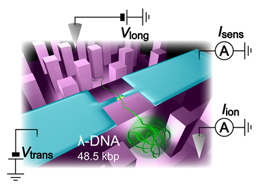Research Abstract
ナノチャンネル内における横電場によるDNAの引きずり
Transverse electric field dragging of DNA in a nanochannel
2012年5月3日 Scientific Reports 2 : 394 doi: 10.1038/srep00394

ナノポア分析は、非光学的でハイスループットなDNA塩基配列決定の新たな1分子解析技術であり、その原理は、DNAがナノポアを通るときに膜貫通イオン電流の遮断、もしくは横方向のトンネル電流を計測することによってそれぞれの核酸塩基の組成を同定することに基づいている。ナノポアによる塩基配列決定の重要な問題は、DNAがナノポアをあまりにも速く移動するので、塩基配列を1分子解像度で決定できないことである。今回我々は、横電場を利用して、この移動速度を遅くすることを報告する。我々は、金の電極を埋め込んだ二酸化ケイ素のチャンネル内に10 mV/nmの横電場を加えることによって、DNAの移動速度が400分の1に低下することを見出した。流動速度を遅くすることで、我々は、ナノポアを通る電流の情報から個々のDNAの局所的な折り畳みパターンを決定することができるようになった。この電場によって引きずる方法は、ポリヌクレオチドの流動ダイナミクスを制御するための新たな方法となる可能性が考えられる。
- 大阪大学 産業科学研究所 バイオナノテクノロジー研究分野
Nanopore analysis is an emerging single-molecule strategy for non-optical and high-throughput DNA sequencing, the principle of which is based on identification of each constituent nucleobase by measuring trans-membrane ionic current blockade or transverse tunnelling current as it moves through the pore. A crucial issue for nanopore sequencing is the fact that DNA translocates a nanopore too fast for addressing sequence with a single base resolution. Here we report that a transverse electric field can be used to slow down the translocation. We find 400-fold decrease in the DNA translocation speed by adding a transverse field of 10 mV/nm in a gold-electrode-embedded silicon dioxide channel. The retarded flow allowed us to map the local folding pattern in individual DNA from trans-pore ionic current profiles. This field dragging approach may provide a new way to control the polynucleotide translocation kinetics.

